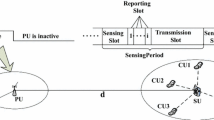Abstract
Cooperative spectrum sensing plays an important role in cognitive radio networks since it improves the detection performance by exploiting spatial diversity. However, the cooperation among terminals also brings additional communication overhead. In this paper, overhead-throughput tradeoff issues are investigated in four scenarios namely (1) identical sensing channel and perfect reporting channel, (2) identical sensing channel and imperfect reporting channel, (3) different sensing channel and perfect reporting channel, (4) different sensing channel and imperfect reporting channel of each secondary user (SU). Taking the reporting overhead into consideration, a novel frame structure consisting of an initial subframe and M consecutive subframes, is proposed to maximize the achievable throughput of the secondary network. And for each scenario, the overhead-throughput tradeoff is formulated as an optimization problem with respect to the number of reporting SUs. A brute-force approach is then used to resolve such optimization problem. Given the optimal number of reporting SUs, a set of candidate SUs is then selected according to the probability of detection, the probability of false alarm and the probability of reporting error. Numerical results show that an optimal overhead-throughput tradeoff is achieved given the optimal number of reporting SUs. In addition, the probability of false alarm is shown to be the most important factor affecting the performance of achievable throughput within the secondary network because the lower probability of false alarm corresponds to the case that the secondary network can use the channel with a higher chance.











Similar content being viewed by others
References
Haykin, S. (2005). Cognitive radio: Brain-empowered wireless communications. IEEE Journal on Selected Areas Communications, 23(2), 201–220.
Zhao, Q., & Swami, A. (2007). A decision-theoretic framework for opportunistic spectrum access. IEEE Wireless Communications Magazine, 14(4), 14–20.
Zhao, Q., & Sadler, B. M. (2007). A survey of dynamic spectrum access. IEEE Signal Processing Magazine, 24(3), 79–89.
Ghasemi, A., & Sousa, E. S. (2007). Fundamental limits of spectrum-sharing in fading environments. IEEE Transactions on Wireless Communications, 6(2), 649–658.
Stotas, S., & Nallanathan, A. (2011). Enhancing the capacity of spectrum sharing cognitive radio networks. IEEE Transactions on Vehicular Technology, 60(8), 3768–3779.
Ganesan, G., & Ye, Li. (2007). Cooperative spectrum ensing in cognitive radio, part II: Multiuser networks. IEEE Transactions on Wireless Communications, 6(6), 2214–2222.
Ma, J., Zhao, G., & Li, Y. (2008). Soft combination and detection for cooperative spectrum sensing in cognitive radio networks. IEEE Transactions on Wireless Communications, 7(11), 4502–4507.
Yucek, T., & Arslan, H. (2009). A survey of spectrum sensing algorithms for cognitive radio applications. IEEE Communications Surveys and Tutorials, 11(1), 116–130.
Cui, T., Gao, F., & Nallanathan, A. (2011). Optimization of cooperative spectrum sensing in cognitive radio. IEEE Transactions on Vehicular Technology, 60(4), 1578–1589.
Chaudhari, S., Lundn, J., Koivunen, V., & Poor, H. V. (2012). Cooperative sensing With imperfect reporting channels: Hard decisions or soft decisions. IEEE Transactions on Signal Processing, 60(1), 18–28.
Sun, H., Laurenson, D. I., Thompson, J. S. & Wang, C.-X. (2008). A novel centralized network for sensing spectrum in cognitive radio. In Proceedings of the IEEE ICC08 (pp. 4186–4190).
Peh, E. C. Y., Liang, Y.-C., Guan, Y. L., & Zeng, Y. (2010). Cooperative spectrum sensing in cognitive radio networks with weighted decision fusion schemes. IEEE Transactions on Wireless Communications, 9(12), 3838–3847.
Shen, J., Jiang, T., Liu, S., & Zhang, Z. (2009). Maximum channel throughput via cooperative spectrum sensing in cognitive radio networks. IEEE Transactions on Wireless Communications, 8(10), 5166–5175.
Fan, R., & Jiang, H. (2010). Optimal multi-channel cooperative sensing in cognitive radio networks. IEEE Transactions on Wireless Communications, 9(3), 1128–1138.
Sun, C., Zhang, W. & Ben, K. (2007). Cluster-based cooperative spectrum sensing in cognitive radio systems. In Proceedings of the IEEE ICC07 (pp. 2511–2515).
Zhang, W., & Ben Letaief, K. (2008). Cooperative spectrum sensing with transmit and relay diversity in cognitive radio networks. IEEE Transactions on Wireless Communications, 7(12), 4761–4766.
Singh, A., Bhatnagar, M. R., & Mallik, R. K. (2012). Cooperative spectrum sensing in multiple antenna based cognitive radio network using an improved energy detector. IEEE Communications Letter, 16(1), 64–67.
Choi, Y.-J., Xin, Y., & Rangarajan, S. (2009). Overhead-throughput tradeoff in cooperative cognitive radio networks. In Proceedings of the IEEE WCNC09 (pp. 1–6).
Zou, Y., Yao, Y.-D., & Zheng, B. (2011). A selective-relay based cooperative spectrum sensing scheme without dedicated reporting channels in cognitive radio networks. IEEE Transactions on Wireless Communications, 10(4), 1188–1198.
Di Renzo, M., Imbriglio, L., Graziosi, F., & Santucci, F. (2009). Distributed data fusion over correlated log-normal sensing and reporting channels: Application to cognitive radio networks. IEEE Transactions on Wireless Communications, 8(12), 5813–5821.
Noel, A., & Schober, R. (2012). Convex sensing-reporting optimization for cooperative spectrum sensing. IEEE Transactions on Wireless Communications, 11(5), 1900–1910.
Liang, Y.-C., Zeng, Y., Peh, E. C. Y., & Hoang, A. T. (2008). Sensing-throughput tradeoff for cognitive radio networks. IEEE Transactions on Wireless Communications, 7(4), 1326–1337.
Pratas, N., Marchetti, N., Prasad, N. R., Rodrigues, A., & Prasad, R. (2010). Centralized cooperative spectrum sensing for ad-hoc disaster relief network clusters. In Proceedings of the IEEE ICC2010 (pp. 1–5).
Peh, E. C. Y., Liang, Y.-C., Guan, Y. L., & Zeng, Y. (2009). Optimization of cooperative sensing in cognitive radio networks: A sensing-throughput tradeoff view. IEEE Transactions on Vehicular Technology, 58(9), 5294–5299.
Acknowledgments
This work is supported by Beijing Natural Science Foundation (4132050), National Nature Science Foundation of China (61121001), Program for Changjiang Scholars and Innovative Research Team in University(No. IRT1049).
Author information
Authors and Affiliations
Corresponding author
Rights and permissions
About this article
Cite this article
Wang, Y., Xu, M., Zhang, W. et al. Overhead-Throughput Tradeoff Under a Novel Frame Structure in Centralized Cooperative Cognitive Networks. Wireless Pers Commun 77, 345–363 (2014). https://doi.org/10.1007/s11277-013-1509-x
Published:
Issue Date:
DOI: https://doi.org/10.1007/s11277-013-1509-x




